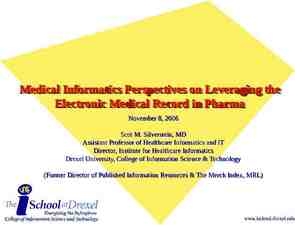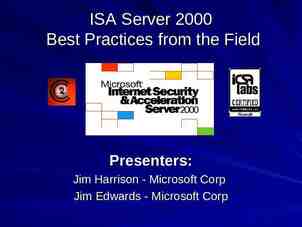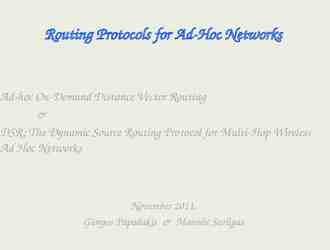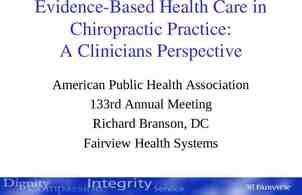Data Communications Program Program Overview Presented to: ACP WG-M
29 Slides4.51 MB

Data Communications Program Program Overview Presented to: ACP WG-M By: Gregg Anderson US Member for OPLINKP Date: February 1-2, 2011 Federal Aviation Administration

History of FAA Continental Data Communications Initiatives Mission Need Statement # 042 JRC Original Program Decision – CPDLC Build I, IA, II, III IOC Miami ARTCC – 09/06 New Data Comm Program Initial Investment Decision – 04/04 Terminate CPDLC Program ZMA Build I Shut Down 10/04 Investment Analysis Readiness Decision – 10/02 CPDLC Build I AMS Investment Analysis Build IA – – 1991 1998 07/08 Provide entry into Final Investment Analysis Data Communications Program ICAO ACP WG-M 2-1-11 Federal Aviation Administration 2

FAA Data Comm CONOPS A TR RTC TO ACO CS W N ER S S Trajectory Based Operations High Performance Airspace WX Reroutes Clearances Time Based Metering Pilot Downlink Fix Tailored Arrivals / CDAs ARTCCs User Flight Operations Control VDL-2 VDL-2 Network TOWER ATCSCC Taxi Instructions Digital ATIS TRACONs Departure Clearance Global Harmonization, Enhanced Safety, Increased Capacity Data Communications Program ICAO ACP WG-M 2-1-11 Federal Aviation Administration 3

What is Data Comm? It is a portfolio consisting of: – Automation Platforms Tower, TRACON, En Route, Oceanic – Network VDL-2 & potentially VDL-0 for DCL SATCOM – Avionics FANS/ATN VDL-2 & potentially VDL-0 for DCL SATCOM – Services Traffic flow management Flight crew requests/reports High availability, guaranteed delivery and low latency times Data exchange for Safety Critical Air Traffic Control (ATC) clearances and instructions Data Communications Program ICAO ACP WG-M 2-1-11 Federal Aviation Administration 4

What will Data Comm do? Safety Eliminate read back / hear back errors Reduce occurrences of pilot deviations Improve human efficiency Fuel Reduce flight times, miles flown and carbon emissions Optimized profiles in all phases of flight e.g.OPD’s Schedule Improve integrity of flight segments Quicker recovery from disrupted operations Data Communications Program ICAO ACP WG-M 2-1-11 Federal Aviation Administration 5

Timeline – Segment 1 Investment Analysis Readiness Decision (2006) Initial Investment Decision (2008) Request for Proposal Release (2011) Final Investment Decision Air Ground Network & Tower Automation Final Investment (2011) Decision for En Route (2012) Tower Initial Site (2014) En Route Initial Site (2017) Data Communications Program ICAO ACP WG-M 2-1-11 Federal Aviation Administration 6

Timeline – Segment 2 Investment Analysis Readiness Decision (2006) Initial Investment Decision (2008) Data Communications Program ICAO ACP WG-M 2-1-11 Final Investment Decision Segment 2 En Route and Approach Control (2018) Segment 2 En Route and Approach Control Implementation (2022) Federal Aviation Administration 7

Data Comm Capabilities – Globally Harmonized 2010 2015 2020 2025 2030 Existing Aircraft Capabilities (FANS 1/A over VDL-2) Aircraft Equipage 214/78 Equipage Avionics Available Avionics Standards DC In Tower Operational Capabilities Validation & Trials DC In En Route Revised Departure Clearances DC In TRACON / Upgrade En Route Optimized Descent (TAP/CDA) Validations D-TAXI In A/C Forward Fit Rule Core Europe Ground Systems Operational Terminal Info Service NAS Status / Delays / Constraints / Sequencing & Hazardous WX 4DLINK / SESAR Implementation Package 1 Implementation Package 2 En Route ATC Clearances Comm Mgmt ATC Microphone Check Initial TAP/CDA’s Data Communications Program ICAO ACP WG-M 2-1-11 Widespread Delegated Separation using ADS-B Interval Management A/C Retrofit Rule / All Europe Ground Systems LINK 2K Widespread 4-D Agreements Conformance Management Initial Trajectory Based Ops European Deployment NextGen Equipage Rule? TRACON Data Comm Including Routine Clearances, Comm Mgmt, & Optimized Descents D-ATIS D-TAXI Out Clearances Comm Mgmt TFM Reroutes Red Terminal Function Black En Route Function Purple Cross Domain Function Segment 3? Segment 2 Segment 1 Complex Clearances Conformance Management Taxi-Out & In; Terminal Info TAP/CDA’s SESAR Implementation Package 3 Widespread 4-D Agreements Widespread M&S / C&P / ITP / PAIRAPP Federal Aviation Administration 8

Why it makes sense to use FANS-1/A( ) (Worldwide Coverage Area for Data Link Services 2007) FANS 1/A ATN w/FANS ATN w/FANS (2011) (2016) FANS 1/A Data Communications Program ICAO ACP WG-M 2-1-11 FANS 1/A Federal Aviation Administration

Data Comm Requires Significant User Investment Segments 1 and 2 Risk-Adjusted Then Year SubNet, 822, Air-Ground Network 14% 12% Automation 43% Automation, 2,517, 42% User,User 2,653, (Equipage) 44% 45% Costs through 2032 Includes development, installation, training, ops, maintenance, etc Data Communications Program ICAO ACP WG-M 2-1-11 Federal Aviation Administration 10

Data Comm Equipage Strategy Users equip once for all segments Ground system evolves 100% Financial incentives – Offset equipage costs Data Comm Equipage Operational incentives – Provide high benefit services – Service for equipage Regulatory Action Regulatory Action – Combination of forward-fit, retro-fit, and/or airspace actions – Aligned with NextGen rulemaking strategy Operational incentives Financial incentives Mandate only without incentives Data Communications Program ICAO ACP WG-M 2-1-11 Federal Aviation Administration 11

CPDLC Provides Enhanced Communications in ALL domains CPDLC Reduces – – – – Controller-Pilot Misunderstandings Radio Operator and Controller-Pilot transcription errors Confusion from non-standard phraseology Radio Frequency congestion CPDLC Provides – Auto-loading of ATC clearances – Standardization of ATC messages across regions – Data formats for pilot down-links that can automatically be integrated into ground automation systems – Increased efficiency w/beneficial results Data Communications Program ICAO ACP WG-M 2-1-11 Federal Aviation Administration 12

Emerging Services Tailored Arrivals – Optimized arrival profile up-linked to aircraft and loaded into FMS Waypoint Management – Managed in-flight spacing using Data Comm for delivery of control times at strategic points 4-D Trajectory Optimization – Enhancements to flight profiles are negotiated via CPDLC ADS-C Oceanic In-Trail Procedures – Separation down to 15NM for climb and descent through a blocking aircraft, and Data Communications Program ICAO ACP WG-M 2-1-11 Federal Aviation Administration 13

Departure Clearance - DCL FANS DCL Service 2014 ATN DCL Service 2017 DCL service consist of: – Initial Departure Clearance – Revised Initial Departure Clearance – Revised Departure Clearance Departure Clearance Defined in SC-214/78 http://www.faa.gov/about/office org/headquarters offices/ato/service units/techops/ atc comms services/sc214/current docs/ FAA Ops Spec A056 recently modified to authorize worldwide Data Communication capability (Continental & Remote airspace) according to your B50 areas of ops Data Communications Program ICAO ACP WG-M 2-1-11 Federal Aviation Administration 14

Revised Pre-departure Clearance Issued to Data Comm Aircraft First - Scenario Non-DC aircraft await pre-departure clearance via voice Photo from Google Earth April 20, 2009 Data Communications Program ICAO ACP WG-M 2-1-11 Federal Aviation Administration

Revised Pre-departure Clearance Issued to Data Comm Aircraft First - Scenario Taxi Queue after Push-back Non-DC aircraft still in Taxi Queue Data Communications Program ICAO ACP WG-M 2-1-11 Federal Aviation Administration

DCL Revised Departure Clearance Benefits Minutes Equipage Rates 30% 60% 100% Projected 12,000 minutes saved July 2009 Better performance in high traffic and adverse weather conditions Data Communications Program ICAO ACP WG-M 2-1-11 Federal Aviation Administration 17

FANS Logon Data Communications Program ICAO ACP WG-M 2-1-11 Federal Aviation Administration

DCL Loadable Clearance Page 1 Data Communications Program ICAO ACP WG-M 2-1-11 Page 2 Federal Aviation Administration 19

User Benefits of Data Comm Summary Significant Reductions in Ground Delays Fuel Savings from TAPs, CDAs, and more efficient routes Increased Sector Throughput More Timely and Effective Clearances More Time to Think and Select Appropriate Actions More Orderly Work Situation During Traffic Rushes Data Communications Program ICAO ACP WG-M 2-1-11 Federal Aviation Administration 20

Data Communications Implementation Team (DCIT) DRAFT Terms Of Reference Background: The Data Communications Implementation Team (DCIT) is an environment for participants to perform advocacy and outreach activities on behalf of the NextGen Data Communications Program. Team members will be able to participate in forums related to integration of ground automation, communication networks, and avionics systems design and certification as well as Data Communication procedures which will enable users to have a stake in the success of the Data Communication Program. Participants include, but are not limited to airframe and avionics manufacturers, FAA, National Airspace System (NAS) users, and related industry associations and business groups. Authority and Administration: Using the DCIT as the umbrella organization, co-chairs from the FAA and Stakeholders will be selected as the Technical and Operational authorities for the integration of Data Communications into NAS operations. Technical and administrative support will be needed and should be provided by the relative participants as required. Issues or information of a proprietary nature will be handled by Non-Disclosure Agreements signed by relevant participants. Data Communications Program ICAO ACP WG-M 2-1-11 Federal Aviation Administration 21

DCIT Draft (con’t) Mission: Provide a forum to advance FAA NextGen Data Communications in the NAS and bring forward guiding principles from the Task Force 5 recommendations which include: – 4.6.1.3.1 Digital ATC-Aircraft Communications for Revised Departure Clearances, Reroutes, and Routine Communications (Operational Capabilities 16, 17, 39, 42a, 44) – The Task Force recommends implementation of this initial set of operational capabilities enabled by Data Comm for aircraft equipped with either FANS 1/A or ATN Baseline 1. Specifically, the services described in capabilities 16, 17, 39, 42, and 44 should be provided to those aircraft equipped with Future Air Navigation Services (FANS) 1/A compliant with RTCA DO-290/2 and DO-258A, conducted over VDL Mode-2 (TSO-C160 ) using the ATC facility notification and controller-pilot data link communication (CPDLC) applications. From the FAA NextGen Web site, Data Communications: – “Advances in data communications between ground and airborne systems are envisioned to increase sector-based traffic capacity allowing greater user access and more efficient flight routing”. Data Communications Program ICAO ACP WG-M 2-1-11 Federal Aviation Administration 22

DCIT Draft (con’t) Participation: Participation is limited to implementers of Data Communications Air Traffic Services in the NAS by authorization of the FAA Program Office. This would include the following major categories and their essential support: – – – – – Operators Communication Service Providers Avionics and aircraft manufacturers FAA Air Traffic Organization FAA AVS (AFS/AIR) Form of commitment for major stakeholders will be by letter to the Co-Chairs, endorsed by the FAA Program Office and the DCIT. Place and Timing of Meetings: The DCIT will meet regularly at the FAA Program Office or other location as mutually agreed upon. It is expected that the DCIT will meet jointly with Data Communications implementers from other worldwide regions on an as needed basis. Data Communications Program ICAO ACP WG-M 2-1-11 Federal Aviation Administration

DCIT Draft (con’t) Tasks: Assist in developing appropriate Roadmap and Transition plans. Carry-on the activities essential to success in integrating the Data Communications segments. Supervise the integration of committed Stakeholders into the Data Communications operational environment. Provide a focus for the integrated planning and test schedules of the stakeholders. Analyze problems reported by participating members and performance metrics of the end-to-end system as prescribed in applicable Data Communications and standards documents. Provide a mechanism for resolution of technical and operational problems through the various standards bodies such as the Data Link User Forum and RTCA. Serve as the Configuration Control Function for Data Communications Baseline Reports, as required, to the FAA Program Office and Air Transport Association. Address Certification and Approval issues as required. Address Human Factors issues as required. Advise the FAA Data Communications Program Manager and related FAA Program Managers on operational and technical issues. Coordinate with other similar regional integration teams, e. g. LINK 2000 Integration Team, (LIT) and FANS Interoperability Team (FIT) as required. Data Communications Program ICAO ACP WG-M 2-1-11 Federal Aviation Administration

Issues Airspace users will not voluntarily equip – Required ROI does not support timely user investment – Economic climate not conducive to airspace user investment – Agency needs to provide incentives and mandate to lead airspace users to NextGen Industry wary of FAA commitment to Data Comm and NextGen – Completing the NextGen Integrated Concept Of Use and Equipage Strategy will reduce industry risk Alignment of decision support tools with Data Comm schedule – ERAM, Automation, etc. Technical and Operational Issues concerning Airborne and Ground systems can not be solved without user participation and implementation – We need your help! Data Communications Program ICAO ACP WG-M 2-1-11 Federal Aviation Administration 25

Summary Several RFC’s have been solicited in the last year – Dedicated ATS Network and Repurposing of Aircraft Radio’s, which – Helped refine our requirements & ready us for the final SIR Data Comm is a key enabler for the NextGen TBO portfolio The Data Comm operational concept was developed to enable TBO Coordinated implementation plans are required – Aligned with Automation Roadmap, TBO portfolio, NextGen Implementation Plan and “Global Implementation Plan” – Coordinated w/Users investment plans Data Communications Program ICAO ACP WG-M 2-1-11 Federal Aviation Administration 26

Meeting the Challenge Coordinating with FAA organizations Collaborating with aviation community RTCA Industry forums Harmonizing with Europeans on standards & operations Industry Coordination is Key to Data Comm’s Success Data Communications Program ICAO ACP WG-M 2-1-11 Federal Aviation Administration 27

How We Want to Fly!!! How We Need to Fly!!! Data Comm – moving traffic with the speed of information Data Communications Program ICAO ACP WG-M 2-1-11 Federal Aviation Administration 28

Questions ? Data Communications Program ICAO ACP WG-M 2-1-11 Federal Aviation Administration






